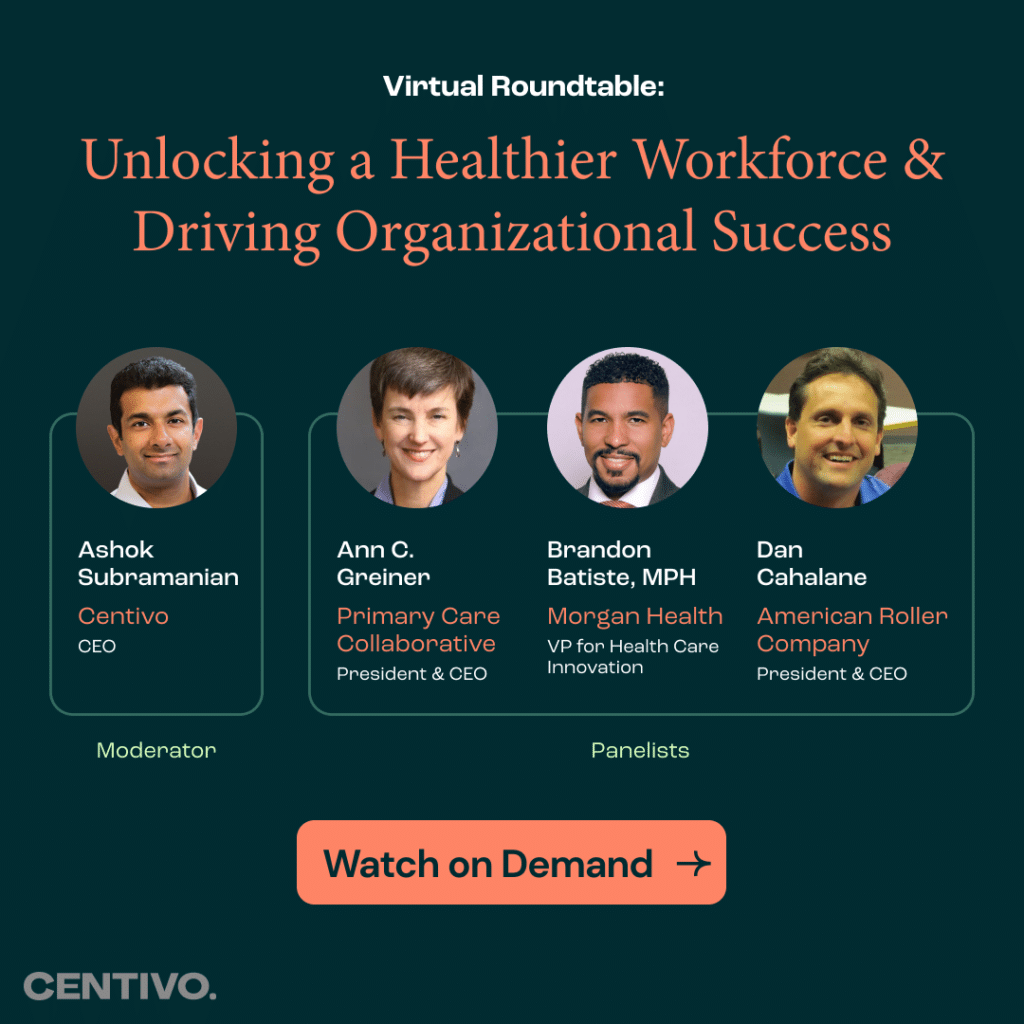In the ever-evolving landscape of healthcare, employer-sponsored health plans play a crucial role in shaping the well-being of employees. It is essential for employers to stay ahead of the curve and explore innovative solutions that not only address the current challenges but also to pave the way for a more sustainable and accessible healthcare system.
Our recent expert panel discussion – Unlocking a Healthier Workforce & Driving Organizational Success – delved deep into the complexities of healthcare benefits, primary care, and organizational success, offering valuable insights for innovative employers and brokers looking to navigate this complex terrain. In this article, we’ll explore key takeaways from their enlightening discussion.
Want to watch the full roundtable? Get access on demand here, or read the full transcript.
Maximizing Value and Controlling Costs
Employers find themselves caught in a relentless cycle where annual rate increases for healthcare benefits outpace salary increases, striking at the core of their competitiveness. This announcement of the annual pay cut underscores a more pressing narrative for both middle and up-market enterprises: the magnetic pull of affordable, effective health benefits cannot be ignored if they wish to stand out in a competitive market for talent acquisition and retention.
“[Our] challenge is keeping up with the Silicon Valley set of employers with whom we compete for talent. We want to make sure that we’re very competitive and able to attract and retain, and we are very thoughtful about the programs that we add to add that extra little hook for employee population,” said Milt Ezzard, VP of Global Benefits & Mobility at Activision Blizzard.
It’s not just the Silicon Valley set that feels this struggle. CEO & President of middle-market manufacturer American Roller, Dan Cahalane, agreed. “We have to recruit people, especially manufacturing folks. We don’t have a foosball table in the lunchroom and Bring Your Dog to Work Day. We’re not necessarily cool. So how do we compete with bigger companies’ luxurious-appearing benefits?”
And coverage challenges have evolved beyond affordability with the Affordable Care Act ushering in an era of expanded coverage and innumerable new point solutions transforming healthcare into a more transactional beast, a labyrinth that employees find increasingly difficult to navigate. Amid this chaos lies the beacon of hope – the untapped potential of primary care. By strengthening what should be the foundation of our healthcare system, we unlock a pathway to not just tame spiraling costs, but to elevate the overall value of employer-sponsored health plans.
Ann Greiner, President & CEO of the Primary Care Collaborative had this to say: “We’ve got a lot more entrants into the market, a lot more variety in the ways that people access care. But I don’t think most people would agree that we have a system that is more coherent. In fact, I think they might say it’s more chaotic and more transactional, less apt for you to have that longitudinal relationship with someone who knows you over time, which the research suggests is actually how you get the best kind of care.”
The call to arms is clear: to safeguard the health of our workforce and the vitality of our organizations, we must boldly champion the cause of primary care. In doing so, we pave the way for a future where health benefits are not just a line-item expense but a strategic lever to drive organizational success and employee well-being.
Driving Organizational Success Through Health Benefits
Employers need to start thinking about health benefits not as another line item on the annual budget, but as an engine that can power organizational success. A successful employer-sponsored health plan does more than check boxes; it prompts engagement from employees in an ecosystem tailored to their needs. Employers need to get transparency into their expenditures and data on how their plans are used to develop an action plan for benefits that work for their employee population.
Morgan Health’s VP for Health Care Innovation, Brandon Batiste, MPH, said: “What does [good] look like? It looks like employers thinking about social determinants of health. It looks like solving for health equity, particularly related to programs that are scalable. And it also looks like integration of behavioral health into primary care. That really takes an organization forward.”
From the affordability perspective, taking the time to understand the needs of the population, and investing more in primary care up front, can save organizations much more overall. “What is proactive strategy to keep people healthy and return them to health?” Greiner asked. “Because that’s really what we should be focused on, not fixing folks after they’ve already gone down the road of a chronic care condition and need a lot of specialist intervention and acute care. Let’s keep them healthy.”
Navigating the Shift Towards Affordable, Accessible and Sustainable Solutions
In the journey toward revolutionizing employer-sponsored health plans, it is incumbent upon CEOs and business leaders to be the vanguards, navigating a course toward affordability, accessibility, and sustainability.
When he joined Activision Blizzard, Ezzard was given the latitude to experiment with their resources to provide something of value. “We’re often the ugly stepsister to the compensation team and the total rewards function, and I wanted to take an opportunity to show that we weren’t just that kind of to be taken for granted set of resources. That we could really have some impact.”
Beyond delighting employees, CEOs must consider profitability. “This is big numbers to the bottom line,” Cahalane noted. “Yes, you have stop loss that can help protect you from the big claims, but the day-to-day that happens is moving the needle of profitability.”
It is also not an undertaking to be achieved overnight. For Cahalane at American Roller it has been a journey over ten years, testing solutions and educating his employees on the values of plan engagement and the function of primary care. “Now they understand that if we can be healthier together, then ultimately, we might – in addition to our health – financially benefit from that. But it takes a long time and repetitive conversations for that to start to stick in the brain.”
To those who are discouraged by disrupting the status quo for their employees, Ezzard had this to say. “We’ve learned along the way that there is a greater tolerance for employer engagement with employee healthcare from the employee standpoint. Ten years ago, it was all about employee choice and giving people flexibility […], but during COVID we learned a lot about people’s willingness to be helped. Their ignorance of how to navigate the system gives us more encouragement that we might be able to push the needle.”
Taking the First Steps
For those employers who are ready to get ahead of the curve and explore innovative solutions that pave the way for affordable, accessible, and sustainable care, our experts had some parting advice.
Dan Cahalane: “There’s a lot of levers to pull in this space. So don’t assume you don’t have a lot of options and approach it as a cost savings, but how can you control the cost and add more value to your employees so that you can use it as a recruiting tool. Challenge your broker to start bringing some ideas that aren’t just the standard rote. Don’t accept that, and you never know what will come up.”
Ann Greiner: “Know your data. Know what the health plans that you contract with are spending on keeping your employees healthy. And then, ask the question about how you’re going to keep folks healthy, because if your expenditures are 3%, I got to tell you, unless you have a very young population, they’re probably not going to be healthy.”
Brandon Batiste: “Look at health equity. Too often a focus on health equity is looked at as a vague commitment rather than a business problem with very specific objectives. So really investing in opportunities to look at the specific needs of your population and then marrying that with the environmental opportunities that DEI brings to support and supplement health equity-based work will really help to push your organization forward as a differentiator in the space.”
To hear more from this distinguished panel, get access to the full roundtable recording on demand here.



